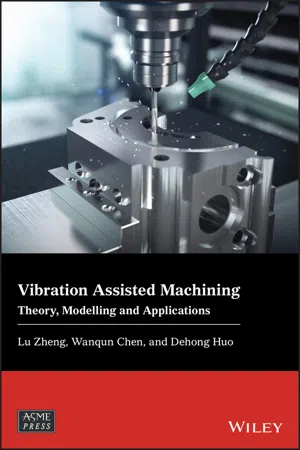
Vibration Assisted Machining
Theory, Modelling and Applications
- English
- ePUB (mobile friendly)
- Available on iOS & Android
About this book
The first book to comprehensively address the theory, kinematic modelling, numerical simulation and applications of vibration assisted machining
Vibration Assisted Machining: Theory, Modelling and Applications covers all key aspects of vibration assisted machining, including cutting kinematics and dynamics, the effect of workpiece materials and wear of cutting tools. It also addresses practical applications for these techniques. Case studies provide detailed guidance on the design, modeling and testing of VAM systems. Experimental machining methods are also included, alongside considerations of state-of-the-art research developments on cutting force modeling and surface texture generation.
Advances in computational modelling, surface metrology and manufacturing science over the past few decades have led to tremendous benefits for industry. This is the first comprehensive book dedicated to design, modelling, simulation and integration of vibration assisted machining system and processes, enabling wider industrial application of the technology. This book enables engineering students and professionals in manufacturing to understand and implement the latest vibration assisted machining techniques. Highlights include:
- Comprehensive coverage of the theory, kinematics modelling, numerical simulation and applications of vibration assisted machining (VAM)
- Case studies with detailed guidance on design, modelling and testing of VAM systems, as well as experimental machining methods
- Discussion of state-of-the-art research developments on cutting force modelling and surface texture generation
- Coverage of the history of VAM, its current applications and future directions for the technology
Vibration Assisted Machining: Theory, Modelling and Applications provides engineering students, researchers, manufacturing engineers, production supervisors, tooling engineers, planning and application engineers and machine tool designers with the fundamentals of vibration assisted machining, along with methodologies for developing and implementing the technology to solve practical industry problems.
Frequently asked questions
- Essential is ideal for learners and professionals who enjoy exploring a wide range of subjects. Access the Essential Library with 800,000+ trusted titles and best-sellers across business, personal growth, and the humanities. Includes unlimited reading time and Standard Read Aloud voice.
- Complete: Perfect for advanced learners and researchers needing full, unrestricted access. Unlock 1.4M+ books across hundreds of subjects, including academic and specialized titles. The Complete Plan also includes advanced features like Premium Read Aloud and Research Assistant.
Please note we cannot support devices running on iOS 13 and Android 7 or earlier. Learn more about using the app.
Information
1
Introduction to Vibration‐Assisted Machining Technology
1.1 Overview of Vibration‐Assisted Machining Technology
1.1.1 Background
1.1.2 History and Development of Vibration‐Assisted Machining
1.2 Vibration‐Assisted Machining Process
1.2.1 Vibration‐Assisted Milling
Table of contents
- Cover
- Table of Contents
- Preface
- 1 Introduction to Vibration‐Assisted Machining Technology
- 2 Review of Vibration Systems
- 3 Vibration System Design and Implementation
- 4 Kinematics Analysis of Vibration‐Assisted Machining
- 5 Tool Wear and Burr Formation Analysis in Vibration‐Assisted Machining
- 6 Modeling of Cutting Force in Vibration‐Assisted Machining
- 7 Finite Element Modeling and Analysis of Vibration‐Assisted Machining
- 8 Surface Topography Simulation Technology for Vibration‐Assisted Machining
- Index
- End User License Agreement